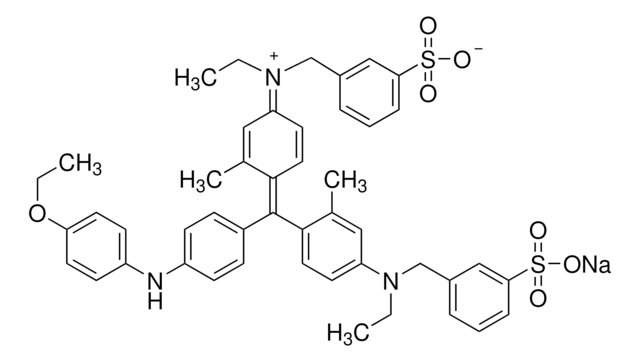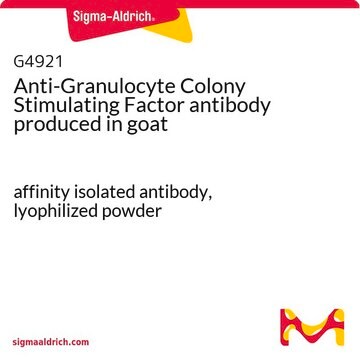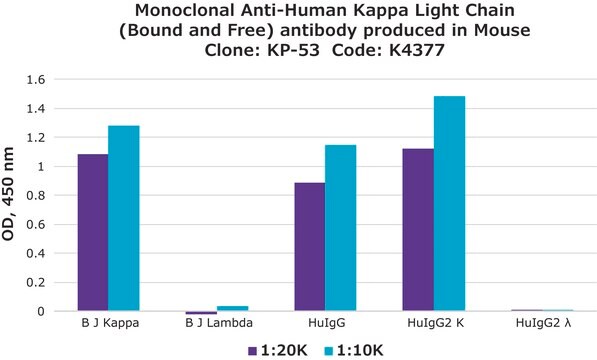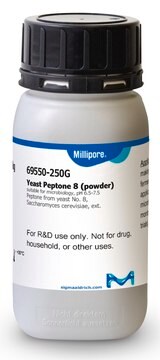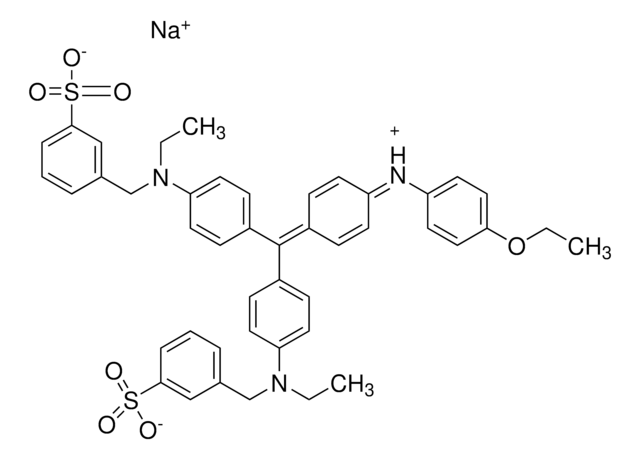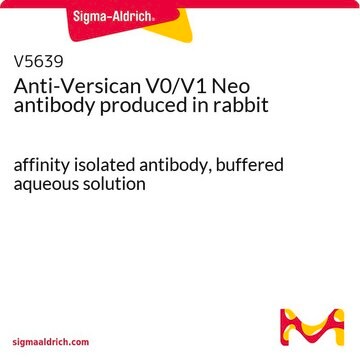G1029
Monoclonal Anti-Granulocyte Colony Stimulating Factor antibody produced in mouse
clone 3316.111, purified immunoglobulin, lyophilized powder
Synonim(y):
Anti-G-CSF
Zaloguj sięWyświetlanie cen organizacyjnych i kontraktowych
About This Item
Polecane produkty
pochodzenie biologiczne
mouse
Poziom jakości
białko sprzężone
unconjugated
forma przeciwciała
purified immunoglobulin
rodzaj przeciwciała
primary antibodies
klon
3316.111, monoclonal
Formularz
lyophilized powder
reaktywność gatunkowa
human
metody
capture ELISA: suitable
neutralization: suitable
izotyp
IgG1
numer dostępu UniProt
temp. przechowywania
−20°C
docelowa modyfikacja potranslacyjna
unmodified
informacje o genach
human ... CSF3(1440)
Powiązane kategorie
Immunogen
recombinant human granulocyte colony stimulating factor.
Działania biochem./fizjol.
Mature myeloid cells are derived from bone-marrow derived precursor cells by the activity of three colony stimulating factors, granulocyte/macrophage colony-stimulating factor (GM-CSF), macrophage colony-stimulating factor (M-CSF) and granulocyte colony-stimulating factor (G-CSF). The expression of G-CSF is the result of activation of pathways in response to tumor necrosis factor-α, LPS and toll-like receptor ligands. The main functions of G-CSF include the generation of neutrophils and induction of the circulation of hematopoietic stem cells from the bone marrow.
Postać fizyczna
Lyophilized from a 0.2 μm filtered solution in phosphate buffered saline containing carbohydrates.
Uwaga dotycząca przygotowania
Purified using protein G.
Oświadczenie o zrzeczeniu się odpowiedzialności
Unless otherwise stated in our catalog or other company documentation accompanying the product(s), our products are intended for research use only and are not to be used for any other purpose, which includes but is not limited to, unauthorized commercial uses, in vitro diagnostic uses, ex vivo or in vivo therapeutic uses or any type of consumption or application to humans or animals.
Ta strona może zawierać tekst przetłumaczony maszynowo.
Nie możesz znaleźć właściwego produktu?
Wypróbuj nasz Narzędzie selektora produktów.
produkt powiązany
Numer produktu
Opis
Cennik
Kod klasy składowania
10 - Combustible liquids
Klasa zagrożenia wodnego (WGK)
WGK 3
Temperatura zapłonu (°F)
Not applicable
Temperatura zapłonu (°C)
Not applicable
Wybierz jedną z najnowszych wersji:
Masz już ten produkt?
Dokumenty związane z niedawno zakupionymi produktami zostały zamieszczone w Bibliotece dokumentów.
H Nagata et al.
The American journal of physiology, 271(6 Pt 1), G1028-G1033 (1996-12-01)
Topical application of ethanol to the gastrointestinal mucosa induces vasodilation. Using an in vivo microscopy technique, we studied the effect of topical ethanol on the submucosal microvessels that control mucosal blood flow in the rat stomach and identified vasoactive substances
R R Ji et al.
Nature neuroscience, 2(12), 1114-1119 (1999-11-26)
We investigated the involvement of extracellular signal-regulated protein kinases (ERK) within spinal neurons in producing pain hypersensitivity. Within a minute of an intense noxious peripheral or C-fiber electrical stimulus, many phosphoERK-positive neurons were observed, most predominantly in lamina I and
Sebastian Stösser et al.
Journal of molecular medicine (Berlin, Germany), 89(4), 321-329 (2010-11-17)
A variety of cancers are accompanied by debilitating pain, which constitutes the primary reason for poor quality of life in cancer patients. There is an urgent demand for the development of specific mechanism-based therapies against cancer pain. Recently, important advances
Sophie Pezet et al.
The European journal of neuroscience, 21(7), 1785-1797 (2005-05-05)
The serine/threonine kinase Akt/PKB has been implicated in cell survival signalling in many cell types, including the dorsal root ganglion (DRG). However, little is known about its role in physiological and pathophysiological conditions in the adult sensory and nociceptive system.
Rong L He et al.
Blood, 113(2), 429-437 (2008-10-28)
The acute-phase protein serum amyloid A (SAA) is commonly considered a marker for inflammatory diseases; however, its precise role in inflammation and infection, which often result in neutrophilia, remains ambiguous. In this study, we demonstrate that SAA is a potent
Nasz zespół naukowców ma doświadczenie we wszystkich obszarach badań, w tym w naukach przyrodniczych, materiałoznawstwie, syntezie chemicznej, chromatografii, analityce i wielu innych dziedzinach.
Skontaktuj się z zespołem ds. pomocy technicznej